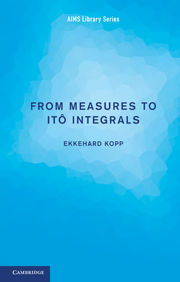1 - Probability and measure
Published online by Cambridge University Press: 05 June 2012
Summary
Do probabilists need measure theory?
Measure theory provides the theoretical framework essential for the development of modern probability theory. Much of elementary probability theory can be carried through with only passing reference to underlying sample spaces, but the modern theory relies heavily on measure theory, following Kolmogorov's axiomatic framework (1932) for probability spaces. The applications of stochastic processes, in particular, are now fundamental in physics, electronics, engineering, biology and finance, and within mathematics itself. For example, Itô's stochastic calculus for Brownian Motion (BM) and its extensions rely wholly on a thorough understanding of basic measure and integration theory. But even in much more elementary settings, effective choices of sample spaces and σ-fields bring advantages – good examples are the study of random walks and branching processes. (See [S], [W] for nice examples.)
Continuity of additive set functions
What do we mean by saying that we pick the number x ∈ [0, 1] at random? ‘Random’ plausibly means that in each trial with uncertain outcomes, each outcome is ‘equally likely’ to be picked. Thus we seek to impose the uniform probability distribution on the set (or sample space) Ω of possible outcomes of an experiment. If Ω has n elements, this is trivial: for each outcome Ω, the probability that Ω occurs is 1/n. But when Ω = [0, 1] the ‘number’ of possible choices of x ∈ [0, 1] is infinite, even uncountable.
- Type
- Chapter
- Information
- From Measures to Itô Integrals , pp. 1 - 11Publisher: Cambridge University PressPrint publication year: 2011

